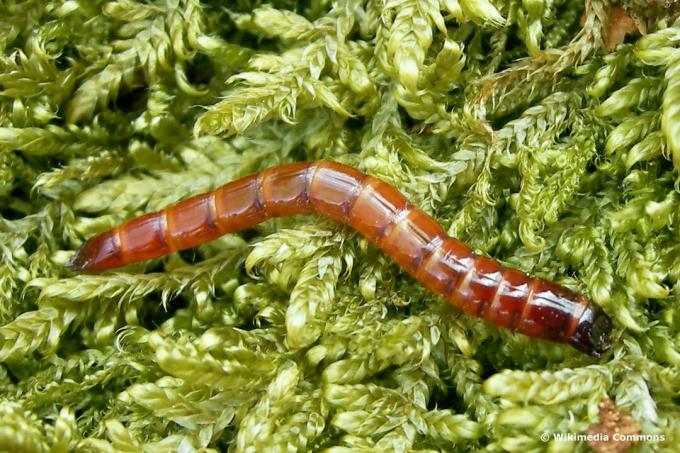
table of contents
- Detect wireworm
- Fight wireworms biologically
- Potato trap
- Dig up the earth
- Insert nematodes
- Garden design close to nature
- Intelligent mixed culture
- Prefer plants
- frequently asked Questions
If your freshly harvested potatoes are criss-crossed by dark aisles, wireworms could be the culprit. What kind of animals are they? How do you look? How do you get rid of them?
In a nutshell
- Wireworm is the larva of the click beetle (Elateridae)
- Common species: Snapback beetle (Agriotes lineatus), yellow-brown click beetle (Agriotes sputator)
- Dreaded pests in potato and vegetable cultivation
- occur more frequently in spring
- adult click beetles harmless
Detect wireworm
Typical features of the wireworm are:
- two to three centimeters in length
- yellow to orange-brown body color
- dark brown head

Source: Danny Steaven, Agriotes-lineatus-011, Edited by Plantopedia, CC BY-SA 3.0
A so-called potato trap helps to make wireworms visible on a bed. This is how you can easily build yourself:
- Cut some potatoes into thick slices.
- Stick the potato slices into the ground about two inches.
- The day after next you can see whether the potato slices have dark aisles or are free of the voracious larvae.
Note: If you find wireworm infestation, move the potato bed to a different location.
Fight wireworms biologically
There are various means available to combat the click beetle larvae naturally. We have listed the most promising ones below.
Potato trap
The potato trap not only helps with recognition, it is also a suitable means of biological control of the pests. It occurs not only on potato-growing areas, but on all of them Vegetable patches for use. Just proceed as described above and then collect the potato slices including the click beetle larvae regularly.

Tip: The potatoes filled with wireworms make a feast for the birds in your garden. Lay out the discs so that the birds can easily see them.
Dig up the earth
Digging up an area will help get rid of click beetle larvae. Proceed according to the following instructions:
- Dig up the bed on a dry, sunny day.
- The wireworms get to the surface. There you can easily recognize and collect them.
- Since the pests are on the menu of many animals, place them so that they are clearly visible for predators such as animals. B. Hedgehog, frog or bird.
Insert nematodes
Nematodes are important helpers in the biological control of various types of pests. This is how the small roundworms help against wireworms:
- to buy in specialist shops
- Pour into watering water according to the instructions for use
- water infested areas with it
- so get into the ground
- invade wireworms
- lay eggs in their bodies
- The result is death of the pests within a few days
- Repeat the application until no more wireworms are visible
Note: Click beetle larvae also get into flower pots via the potting soil, where they wreak havoc. Watering with nematodes quickly leads to success here too.
Garden design close to nature
In gardens in which Hedgehog, Birds and many beneficial insects feel good, click beetle larvae have no chance of survival. They are eaten faster than they can cause damage.
Intelligent mixed culture
For decades, vegetable farmers have been looking for suitable solutions to combat wireworms without chemicals. One way to drive the pests away in a sustainable manner is that Mixed culture. Tagetes or marigolds (Calendula officinalis), for example, are a suitable means of repelling pests. Plant a few of the bright orange flowers between the vegetable patches.

Prefer plants
The stronger the potato and vegetable plants are, the less they are threatened by pests. Pulling them forward on the windowsill increases the stability and resistance of the plants.
Note: Lawns are particularly at risk of wireworm infestation. If you are planning to convert a lawn into a vegetable patch, remove the sward thoroughly. Dig up the area well and leave it fallow for two years if possible. Check the area regularly for larvae.
frequently asked Questions
Grassy areas and freshly dug soils are extremely attractive to click beetle larvae. We recommend not planting vegetables in the bed immediately after digging it up. The pests are also very fond of moisture. For this reason, the loosened soil should dry well before planting begins. If possible, beds that are intended for growing vegetables should not be left fallow for a year after they have been digged up. Lime fertilizers help drive away the wireworm.
From June to July, female click beetles lay up to 250 eggs in small packages of around 20 pieces two centimeters deep in the ground. The larvae hatch after five to six weeks. They take three to four years to develop.
The robust pests spend the cold season well protected in the ground at a depth of around 60 centimeters.



